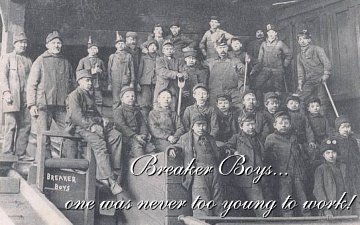

| "Wednesday, March 10, 1897" "I am in a foul mood! It is harder than I ever imagined to take care of four grown men, one brother, and three daughters. My hands are raw from doing too much wash and from picking coal in the cold. I have no time to comb my hair, and it has grown as tangled as a rat's nest..." ~A Coal Miner's Bride, The Diary of Anetka Kaminska, by Susan Campbell Bartoletti |
| The diary entry above was made by a young
Polish immigrant who was not yet out of her teens! Though a work of fiction, her
life reflected the lives of a great majority of the population in Victorian times.
Though enamoured with the elegance, refinement, and beauty of the era, we would do well to
remember that not everyone lived in fine houses with gilding and servants. Many,
many people, especially those in the coal mining patch towns of the northeast, lived lives
of back breaking labor and struggle. Their labor and their lives, lives often cut
short by accidents, poverty, and disease, fueled the industrial revolution.
While the coal barons lived in mansions replete with every luxury, the coal miner
descended to the bowels of the earth before the sun rose, spent his day in danger and
darkness, and returned home after the sun had set, if he was lucky enough to return at
all. In the meantime, his wife and his children labored to survive above ground,
sharing a community well and trying to eke out an existence with the little they had, in
homes that were often little more than shacks. Day after day, week after week they
continued, despite the fact that on payday, the miner often ended up owing the company
more than he made. Some companies paid their miners in company "scrip". Since the scrip was not legal tender, the buyer could only make purchases at a facility that was willing to accept it. Each coal company issued its own scrip, which was rarely accepted at any place other than that particular mine's Company Store. Those places other than the Company Store that did accept the scrip usually discounted the value of the scrip, sometimes as much as 50 percent. In many places, scrip became the unofficial currency of the community, even being placed in the collection plates of churches during sunday services. Many miners were never able to fully resolve their debt to the company store and the debt passed to their family upon the miner's death. The company homes were owned by the mining company as well, and if a miner was inconsiderate enough to die on the job, his widow and children were often put out as they were unable to pay the rent. They received no pension, no severance, no consideration of any kind, regardless of the years or the effort. |

PUBLISHED BY THE ROTOGRAPH COMPANY, NEW YORK, N.Y. 1907
| Every wife dreaded the whistle in the middle of the day that heralded an accident in the mine. The sight of The Black Maria (a black, enclosed carriage used to transport the dead from the mine to their home) sent a chill down the spine of everyone in the town as they waited to see where it would stop. "An accident in the mines was made known by the blowing of mines whistles, and train whistles... This was the signal for women and children to come out of their homes and line the street as the wagons brought the victims back to town. As each wagon would pass, the women would anxiously inquire of whom it contained. When the hearse came along, the process was repeated with each family dreading to find that it contained a father, son, or brother. In this awesome lottery, someone had to get the bad news." ~Tales of the Mine Country, by Eric McKeever Frequently the bodies were tossed on the porch without a word of condolence or sorrow. My grandmother relates that when her father was run down by a car filled with coal, the body was tossed on the porch and left for the family to care for. Fortunately for her family, she and her siblings were by then grown and married and so her widowed mother had one less thing to worry about! |

PUBLISHED BY THE ROTOGRAPH COMPANY, NEW YORK, N.Y. 1907
| Surely it is more exciting to read and learn about balls and parties, wealth and manners, but we do ourselves and our ancestors a disservice if we subscribe to the theory that everyone lived like the Astors. Most did not. Most struggled and scrimped and even died so that we, today, could enjoy the lives and privileges that we have. Even those who today, do not live lives of ease and comfort, are probably in better situations that those who came before. And so when we remember the "Gilded Age", let us not forget those whose lives did not "glitter", but were no less important!
For further information on the lives of 19th century mining families, Granny recommends the following books:
A fictional account based on fact depicting the life of a yong immigrant girl and her struggles to survive and find happiness. A particularly good account of life in the mines. A collection of factual stories colledted by the author from miners and their famlies. The story of a Welsh mining famly in the 19th century. This family was perhaps a little more well-to-do than most families in the northeastern part of the US in the same time period, but faced many of the same labor issues ans struggles. An award winning picture!
Related Links of Interest
Disclaimer: Granny's Closet provides the information contained in this website for information and entertainment purposes only and neither endorses or takes responsibility for the use of any of the information found herein. Graphic design and the contents of "Granny's Closet" © 2002-2003. Updated March 4, 2003 |